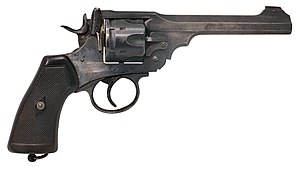Webley Revolver
| Webley Mk VI Revolver | |
|---|---|
 |
|
| Type | Service Revolver |
| Place of origin | British Empire |
| Service history | |
| In service | 1887–1963 |
| Used by | See Users |
| Wars |
Second Boer War World War I Easter Rising Irish War of Independence Irish Civil War World War II Indonesian National Revolution Korean War British colonial conflicts The Troubles Dissident Irish Republican campaign numerous others |
| Production history | |
| Designer | Webley & Scott |
| Designed | 1887 |
| Manufacturer | Webley & Scott, RSAF Enfield |
| Produced | 1887–1923 |
| Number built | approx 125,000 |
| Specifications | |
| Weight | 2.4 lb (1.1 kg), unloaded |
| Length | 11.25 in. (286 mm) |
| Barrel length | 4.17 in. (106 mm) |
|
|
|
| Cartridge | .455 Webley Mk II |
| Calibre | .455 (11.6 mm) |
| Action | Double Action revolver |
| Rate of fire | 20–30 rounds/minute |
| Muzzle velocity | 620 ft/s (190 m/s) |
| Effective firing range | 50 yd |
| Feed system | 6-round cylinder |
| Sights | Fixed front blade and rear notch |
| Webley Mk IV .38/200 Service Revolver | |
|---|---|
| Type | Service revolver |
| Place of origin | British Empire |
| Service history | |
| In service | 1932–1963 |
| Used by | United Kingdom & Colonies, British Commonwealth, |
| Wars | Second World War, Korean War, British colonial conflicts, numerous others |
| Production history | |
| Designer | Webley & Scott |
| Designed | 1932 |
| Manufacturer | Webley & Scott |
| Produced | 1932–1978 |
| Number built | approx. 500,000 |
| Specifications | |
| Weight | 2.4 lb (1.1 kg), unloaded |
| Length | 10.25 in (266 mm) |
|
|
|
| Cartridge | .380" Revolver Mk IIz |
| Calibre | .38 (9 mm) |
| Action | Double Action revolver |
| Rate of fire | 20–30 rounds/minute |
| Muzzle velocity | 620 ft/s (190 m/s) |
| Effective firing range | 50 yd (46 m) |
| Maximum firing range | 300 yd (270 m) |
| Feed system | 6-round cylinder |
| Sights | fixed front post and rear notch |
The Webley Revolver (also known as the Webley Top-Break Revolver or Webley Self-Extracting Revolver ) was, in various marks, a standard issue service pistol for the armed forces of the United Kingdom, and the British Empire and Commonwealth, from 1887 until 1963.
The Webley is a top-break revolver and breaking the revolver operates the extractor, which removes cartridges from the cylinder. The Webley Mk I service revolver was adopted in 1887 and the Mk IV, rose to prominence during the Boer War of 1899–1902. The Mk VI, introduced in 1915 during the First World War, is perhaps the best-known model.
Firing large .455 Webley cartridges, Webley service revolvers are among the most powerful top-break revolvers ever produced. The .455 calibre Webley is no longer in military service but the .38/200 Webley Mk IV variant is still in use as a police sidearm in a number of countries. With a modified, "shaved" cylinder and the use of a half moon clip, the Webley Mk VI can fire the 45 ACP cartridge, although overpressure or +P .45 ACP cartridges exceed Webley proof loads and should not be used. Many Webley Mk VIs were converted to fire 45 ACP ammunition after the remaining .455 Webley ammunition dwindled.
The British company Webley & Scott (P. Webley & Son before merger with W & C Scott in 1897) produced a range of revolvers from the mid 19th to late 20th centuries. As early as 1853 P. Webley and J. Webley began production of their first patented single action cap and ball revolvers. Later under the trade name of P. Webley and Son, manufacturing included their own .44-caliber rim-fire solid frame revolver as well as licensed copies of Smith & Wesson's Tip up break action revolvers. The quintessential hinged frame, centre-fire revolvers for which the Webley name is best known first began production/development in the early 1870s most notably with the Webley-Pryse (1877) and Webley-Kaufman (1881) models. The W.G. or Webley-Government models produced from 1885 through to the early 1900s, (often incorrectly referred to as the Webley-Green) are the most popular of the commercial top break revolvers and many were the private purchase choice of English military officers and target shooters in the period, coming in a .476/.455 calibre. However other short-barrel solid-frame revolvers, including the Webley RIC (Royal Irish Constabulary) model and the British Bulldog revolver, designed to be carried in a coat pocket for self-defence were far more commonplace during the period. Today, undoubtedly best-known are the range of military revolvers, which were in service use across two World Wars and numerous colonial conflicts.
...
Wikipedia
